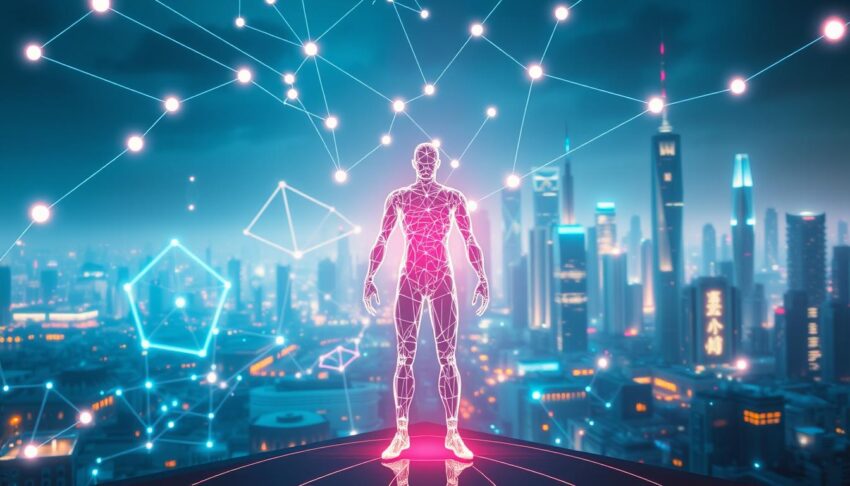Ever wondered why some AI models do so well with little data? That's where Transfer Learning comes in. It's a key part of deep and machine learning. It helps models learn from one task to another, making them better and faster.
This part talks about why Transfer Learning is important. It shows how it helps with data and makes AI better in many ways.
Key Takeaways
- Transfer Learning lets us use old models, saving time and money.
- It helps AI systems do well even with little data.
- This method is vital for improving deep and machine learning.
- Learning about Transfer Learning helps us understand AI better.
- It makes AI apps more useful and easy to use.
Understanding Transfer Learning
Transfer Learning is a big deal in machine learning. It helps models do better by using what they learned before. This makes training faster and helps models work well in different areas.
Definition and Key Concepts
The Transfer Learning definition is about using what a model learned before to help it do better on a new task. It's all about knowledge transfer. The model uses what it knows from before to learn new things faster.
Domain adaptation is also key. It shows how models can work well in different places. For example, a model that learned to recognize images in cities can learn to recognize images in the countryside too.
History and Evolution of Transfer Learning
Transfer Learning has been around for a while. It started with early machine learning studies. These studies showed how it could make learning more efficient.
As computers got better, so did Transfer Learning. New algorithms and deep learning helped make it even better. Now, it's a big part of AI.
The Importance of Transfer Learning in AI
Transfer learning is key in making AI better and faster. It uses pre-trained models to save a lot of time. This is very helpful when time and resources are tight.
Enhancing Efficiency and Reducing Training Time
In today's fast world, making AI work well fast is important. Efficiency in AI is a big goal. Transfer learning helps systems learn quickly from what they already know.
This means models can be used sooner. They don't need to spend a lot of time learning from lots of data.
Bridging Gaps in Data Scarcity
Not having enough data is a big problem for AI. In some areas, getting enough labeled data is hard. Transfer learning helps by making the most of what little data there is.
This makes AI models work better, even with less data. It makes AI systems stronger and more reliable.

How Transfer Learning Works
Transfer learning is very good at using what it learned before to do new things. It takes what it knows from one area and uses it in another. This makes it very useful in real life.
The Mechanism of Knowledge Transfer
Transfer learning uses big datasets to help with new tasks. It takes important features from old models to help with new ones. This way, it can learn and do well in new areas.
Common Techniques in Transfer Learning
There are a few key ways to use transfer learning. Fine-tuning models and feature extraction are two big ones. Fine-tuning means changing some parts of a model to fit a new task. It saves time and effort.
Feature extraction is when you use what a model learned without changing it. You take its features and use them for a new task. This is very flexible and works well in many areas.
| Technique | Description | Advantages |
|---|---|---|
| Fine-tuning Models | Adjusting weights of pre-trained models for specific tasks. | Reduces training time, leverages rich representational power. |
| Feature Extraction | Using outputs of certain layers as input for new classifiers. | Minimal data requirements, simplifies model deployment. |
Applications of Transfer Learning in Various Domains
Transfer learning is used in many areas. It makes artificial intelligence better. It helps in image recognition, natural language processing, and healthcare technology.
Image Recognition and Computer Vision
Transfer learning is key in image recognition and computer vision. Convolutional Neural Networks (CNNs) use it for tasks like object detection. They can quickly learn to spot objects in images.
Natural Language Processing
Natural language processing (NLP) has changed thanks to transfer learning. It makes machines better at understanding language. This helps in tasks like language translation and text summarization.
Healthcare and Medical Imaging
In healthcare, transfer learning is changing medical imaging. It makes diagnostic tools more accurate. Models can spot diseases like cancer early.

| Application Domain | Benefits of Transfer Learning | Notable Techniques |
|---|---|---|
| Image Recognition | Improved accuracy, reduced training time | CNNs, Feature Extraction |
| Natural Language Processing | Enhanced understanding of language, efficient data processing | Transformer models, BERT |
| Healthcare and Medical Imaging | Increased diagnostic accuracy, effective disease detection | Transfer learning in CNNs, ImageNet models |
Transfer Learning vs Traditional Machine Learning
It's important to know the difference between transfer learning and traditional machine learning. They work in different ways. This is key in today's world where we need to use AI wisely.
Differences in Data Requirements
Traditional machine learning needs lots of labeled data. Getting and labeling this data takes a lot of time and effort. But, transfer learning uses pre-trained models. This means it can work well even with little data.
This is great for places where getting data is hard or expensive.
Adaptability and Generalization Capabilities
Transfer learning is better at adapting to new tasks. It can fine-tune pre-trained models for new tasks. This makes it good at working in many areas.
Traditional machine learning models can get stuck on the data they were trained on. They don't do as well with different data.
Challenges and Limitations of Transfer Learning
Transfer Learning is very helpful, but it has big challenges. One big problem is when the data from the source and target datasets don't match. This can make the model not work well. It's important to know how to fix these problems to get better results.
Domain Mismatch Issues
Domain mismatch means the data from the training and target datasets are very different. This can make the model not perform well. For example, a model trained on one type of image might not work well on another type.
To solve this, we use domain adaptation and fine-tuning. These help make the data from both domains match better.
Overfitting and Model Performance
Another big challenge is overfitting. This happens when a model gets too complex and learns the noise in the data. It often happens when we don't fine-tune the model enough.
This can make the model work great on the source data but not on new data. To fix this, we use early stopping and cross-validation. These help make the model strong and reliable.
Transfer Learning in Deep Learning Frameworks
Deep learning frameworks are key for using Transfer Learning models. TensorFlow and PyTorch are top choices. They make it easy to use pretrained models for new tasks.
Popular Frameworks Supporting Transfer Learning
TensorFlow has a big ecosystem for deep learning. Its Keras API makes it easy to use pretrained models. You can use models like VGG16 for image tasks.
PyTorch is great for trying out Transfer Learning. It works well with models like BERT for language tasks. Its easy-to-use syntax is a big plus.
Examples of Pretrained Models
Pretrained models save a lot of time and resources. VGG16 and ResNet are good for images. BERT is best for understanding language. You can pick the right model for your project.
| Model | Type | Key Features | Framework |
|---|---|---|---|
| VGG16 | Image Classification | Deep architecture with small filter sizes | TensorFlow, PyTorch |
| ResNet | Image Classification | Residual connections for deeper networks | TensorFlow, PyTorch |
| BERT | Natural Language Processing | Bidirectional transformer for deep context | TensorFlow, PyTorch |
The Future of Transfer Learning in Artificial Intelligence
Transfer Learning is changing fast. New trends and ideas are making it better. These changes will help AI get smarter and more useful in many areas.
Trends and Innovations on the Horizon
Deep learning is moving towards better Transfer Learning. Companies are working on:
- Cross-domain Transfer Learning: Making it easier to use knowledge from one area in another.
- Self-supervised Learning: Helping models learn from data without labels, making training faster.
- Modular Neural Networks: Creating models that are easier to build and change.
Potential Impacts on AI Development
Transfer Learning's growth will change AI in big ways. It might lead to:
- Improved Model Performance: Making models work well even with little data.
- Faster Iteration Cycles: Helping teams get results quicker, so they can act fast.
- Enhanced Accessibility: Making AI easier for small companies to use, helping everyone.
Conclusion
In this Transfer Learning recap, we've seen how it changes artificial intelligence. It makes training faster and helps when there's not much data. This is true for things like seeing pictures and understanding language.
Transfer Learning is very important in AI. We've learned how it makes models better, faster, and more accurate. It's not just a trend; it's a big step forward for AI.
The future of Transfer Learning looks good. New ideas will make AI even better. Using Transfer Learning will help experts make AI more amazing.
